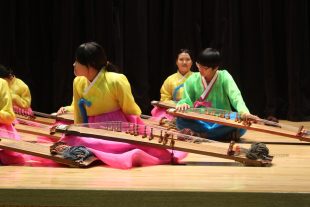Improvisation extends possibilities of Korean music
At the Yeowoorak Festival, which celebrates unlimited possibilities of Korean music, there is something new and unique every year. This year, the festival set stages for reunions of legendary Korean music performers such as master pansori singer Ahn Sook-sun and her friends for “Ahn Sook-sun & Jieum” and the return of Korean music ensemble Baramgot in six years for “Bari Sinawi.”
Soloist Ensemble Sangsang, a gugak project trio, is reuniting after 13 years to perform “Karma DMZ” with sound artist Kim Chang-hun, July 15, at the Haneul Round Theater of National Theater of Korea (NTOK) on Namsan Mountain.
Sangsang consists of haegeum (two-stringed fiddle) player Gang Eun-il, geomungo (six-string zither) player Heo Yoon-jeong and cheolhyeongeum (steel-stringed zither) and percussion player Yu Kyung-hwa.
The three musicians met for the first time at the National Gugak High School, which was located at the current NTOK site.
“When we were in third grade, samulnori (traditional percussion quartet) was very popular and our principal set a group of students to learn samulnori, which was neglected in the school curriculum centering on Korean court music,” Heo said. “It marked a turning point for us. We were so fascinated by samulnori instruments that the principal had to confiscate them so we could focus on our majors.”
Among the three, Gang was the first to taste the charm of free improvisation and she performed with master improvising musician Kim Dae-hwan in the early 1990s. Her friends came to see her free music performance and they sometimes performed impromptu pieces, which led them to form the trio in 2000.
“Back then, there were no gugak musicians doing improvisations. I was one of the first to pioneer it,” Gang said.
Heo named the ensemble Sangsang, which means imagination in Korean. “Our music is different from existing music and all kinds of sound can become music in us. So imagination was the key to our music,” Heo explained.
Soloist Ensemble Sangsang was mainly active from 2000 to 2005 and the three performed monthly at a small theater in southern Seoul.
“We experimented with almost everything. We collaborated with other improvisation musicians from Korea and overseas and Western classical style musicians. We opened our minds and tried to absorb and learn as much as possible,” Gang said.
Yu originally majored in geomungo, but she was more active as a percussionist. Then she fell in love with cheolhyeongeum, a hybrid between gayageum (12-string zither) and Hawaiian guitar (lap steel guitar) invented in the 1940s, but much forgotten. Her cheolhyeongeum sound added more versatility to the music of Sangsang.
“There are possibilities for improvisation in Korean traditional music as many of music styles such as sanjo and sinawi are originated from improvising,” Yu said. “However, what we learned was to play with a score and use techniques from our teacher. There was an indescribable pleasure of freedom when I was able to perform solely on my own.”
However, Yu emphasized that the free improvisation can only come from becoming proficient in existing techniques and skills. “As I played more and more improvised music, I felt I lacked something. But it was always exciting to be influenced by two musically prominent friends of mine,” Yu said.
Yu picked their 2004 concert at the Seoul Arts Center as one of the most memorable events.
“Previously in the Korean traditional music scene, composers handed down scores or performers reinterpreted existing traditional music. However, we changed the approach and the composers came up with rough draft and each instrument’s player filled in the blanks. The composer and the player were able to supplement each other through the method,” Yu said.
DMZ sound meets gugak
For the last 13 years, Gang, Heo and Yu have been focusing on their individual projects and Sangsang was set aside for a while.
“It’s been over a decade and we were thinking about a reunion as Soloist Ensemble Sangsang. When Yeowoorak Festival contacted us as Sangsang, we knew this was the chance,” Heo said. “Yeowoorak puts emphasis on collaboration of musicians from different genres and we wanted to awaken the message of Sangsang once again. It might not be safe and easy to understand, but we will challenge the conventional way of thinking.”
For the collaboration, Sangsang picked sound artist Kim Chang-hun of Soundscape, who collected natural and artificial sound-scapes from the Korean Demilitarized Zone (DMZ).
“As we get older, we are musically inclined to the sound of nature. The sound of DMZ is unknown to us and we thought it would be interesting to tackle it,” Heo said.
The three listened to the sounds collected from the DMZ and conceived solo musical pieces for the upcoming concert.
“Kim collected these sound sources from the DMZ for some 10 months. When we think of the DMZ, we only think of preserved nature, but in fact there’s much more than that. There are sounds of soldiers, explosives, visitors and temple bells. We can even hear the vibration of the earth, which we cannot hear with our ears,” Gang said.
Gang added that the sound of DMZ represents the history of war, of which every Korean feels. “We are not climbing on the bandwagon of the thaw of inter-Korean relations, but just want to explore the synergy of our music and natural sound,” Gang said.
By Kwon Mee-yoo
(Korea Times)





























































